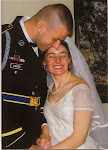 |
| Phidias: The Cavalcade-Balance, Function, and True Beauty |
There are so many memories in this room, and yet as I think about them, I realize that they all represent a common heritage and a common philosophy. Tristan expressed it well when he called home last night. He was in the midst of processing a particularly virulent attack on about everything he believes, and needed a sounding board. I was it. The article was a generalized attack on traditional Graeco-Roman concepts of beauty. It maintained that they were merely long established tyrannies of the historic male hegemony which oppressed women and those who did not meet the traditional sculptor's standard of beauty. Tristan responded that in design, good form always follows function, and that certain physical attributes are historically valued because they enhanced performance in a particular realm. Furthermore, to maintain and develop those attributes, certain desirable social qualities are essential, like self-discipline, restraint, hard work, enhanced levels of understanding, and dedication to reaching goals. He added that the article seemed to be written by a person who was unwilling to practice those "virtues" necessary to exhibit that beauty of form which follows and enables human function in its highest expression. In short, the writer was, in his opinion, lazy, undisciplined, unwilling to sacrifice, and far too willing to blame their own rejection on the attitudes of others rather than on their own unwillingness to cooperate with those laws of nature which are self evident; those laws which in an earlier age brought death or slavery to those who ignored them.
I suppose the vast majority of my nick knacks and keepsakes are reminders of what Tristan called "Traditional Values." They remind me of old comrades, of shared sacrifice and hard work, of heroism and the disciplines which preserved freedoms and built empires-spiritual as well as political or economic. In a very real sense, they call me to examine my spiritual life, and to realize that my physical and intellectual lives are important expressions of that "spiritual life" which I value so much. Certainly, my salvation is all of grace. It is freely given by Jesus Christ through the blood of the everlasting covenant. I neither deserve it, nor can I do anything to attain it. But once it becomes the defining feature of my life, I am changed forever, and called to put aside those bad habits of laziness, and thoughtlessness, and selfish lusts of the flesh and mind. I am called to so discipline myself in grateful humility that I do my best to follow the example of who Jesus is and what he does in history. The virtues of temperance, self-control, hard work, personal discipline, dedication, and submission to the revealed will of God- along with so many others, enable me by God's grace to be more like Jesus, that his work might be done in this world.
David Brainerd, the early Puritan missionary to the natives of New England, lamented that God had given him a message to proclaim and a horse from which to proclaim it. By not taking care of his physical health, he said, "I have killed the horse, and now I have no way to deliver the message." His words call us all to pay closer attention to the exercise of the traditional virtues in our lives. God calls us to do our best to develop physical, emotional, educational, and spiritual health that we might be able to serve him more faithfully and fully. It is true that not all of us start with the same raw materials in every area. Some of us have found our abilities to develop in one area or another severely limited by accidents of nature beyond our control or by bad decisions we made in the past. But whatever our situation, we are called in the here and now to do the best we can with what we possess in the present. To labour toward that end is to attain true beauty in both the Classical sense and in the Christian sense.
Thank you Tristan, for reminding me why I kept all of this junk. In the weeks to come, might we all commit ourselves to the practice of those virtues which will help us to build stronger bodies, stronger minds, stronger relationships with each other, and more intimate relationships with Jesus Christ, our Saviour and Lord, my Master.
Faithfully,
Bill+












No comments:
Post a Comment